目前還是一個學(xué)生,項目不會做,只能寫一些學(xué)習(xí)筆記,沒有什么經(jīng)驗(可能一些自己判斷的有一定錯誤,內(nèi)容僅作為參考),
個人認(rèn)為一個健全的項目首先就需要一個bootloader,所以就淺淺記錄一下自己使用rtthread studio配置qboot和app工程的制作過程.
使用工具:rtthread studio
移植qboot工程過程
1.創(chuàng)建工程
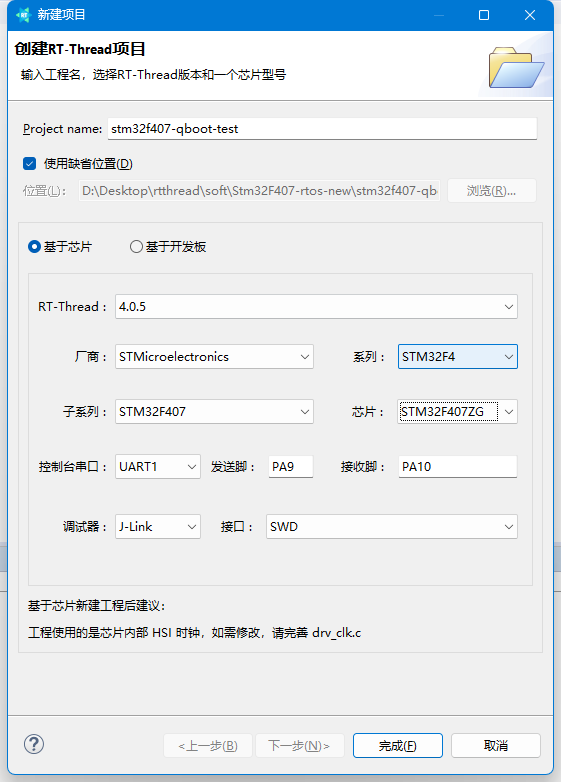 1.1 創(chuàng)建qboot的項目工程
1.1 創(chuàng)建qboot的項目工程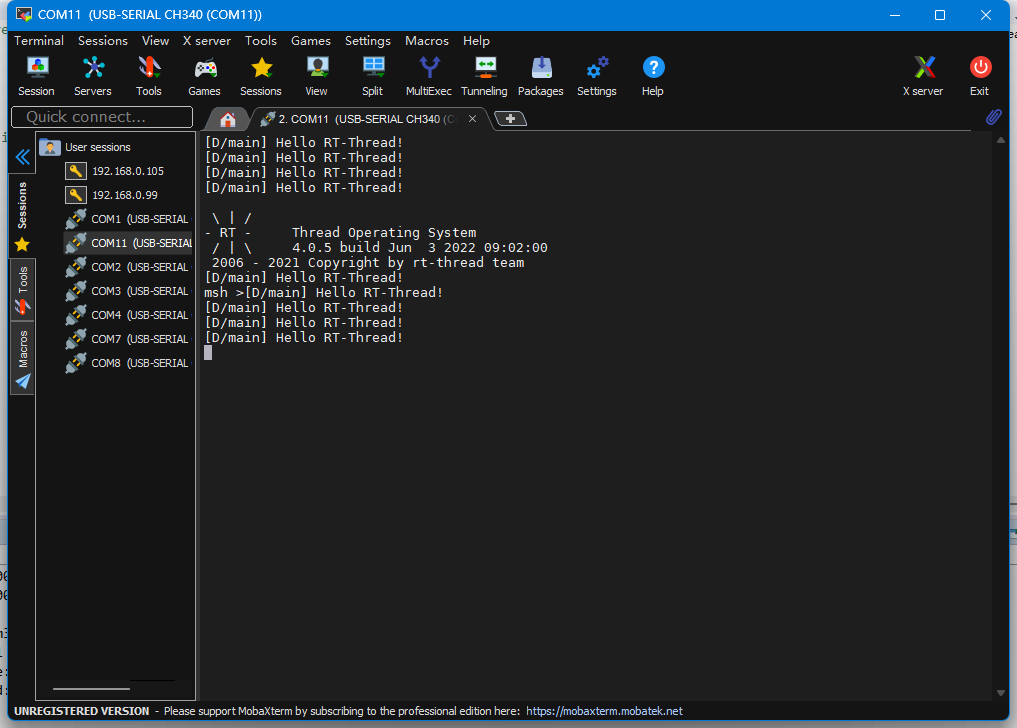 1.2 淺跑一下試試
1.2 淺跑一下試試2.開始配置spi的外部flash – w25q16 (這里使用spi1,可根據(jù)具體調(diào)整)
 2.1 spi硬件連接
2.1 spi硬件連接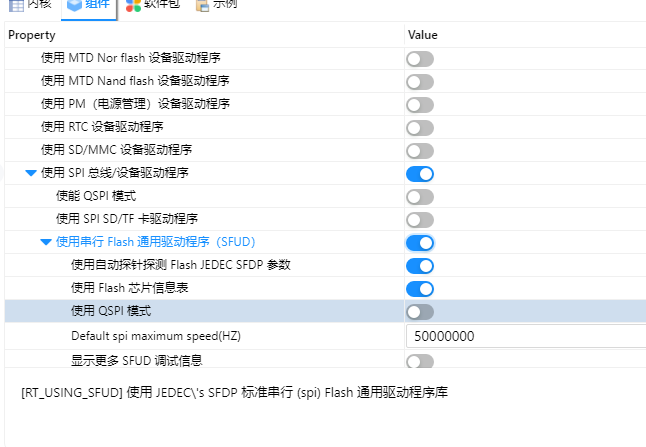 2.2 在rtthread setting內(nèi)開啟spi
2.2 在rtthread setting內(nèi)開啟spi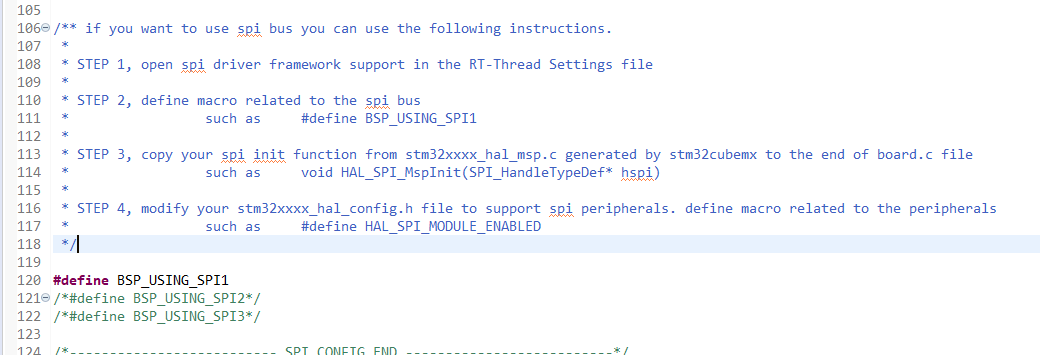 2.3 在board.h內(nèi)開啟使用spi1
2.3 在board.h內(nèi)開啟使用spi1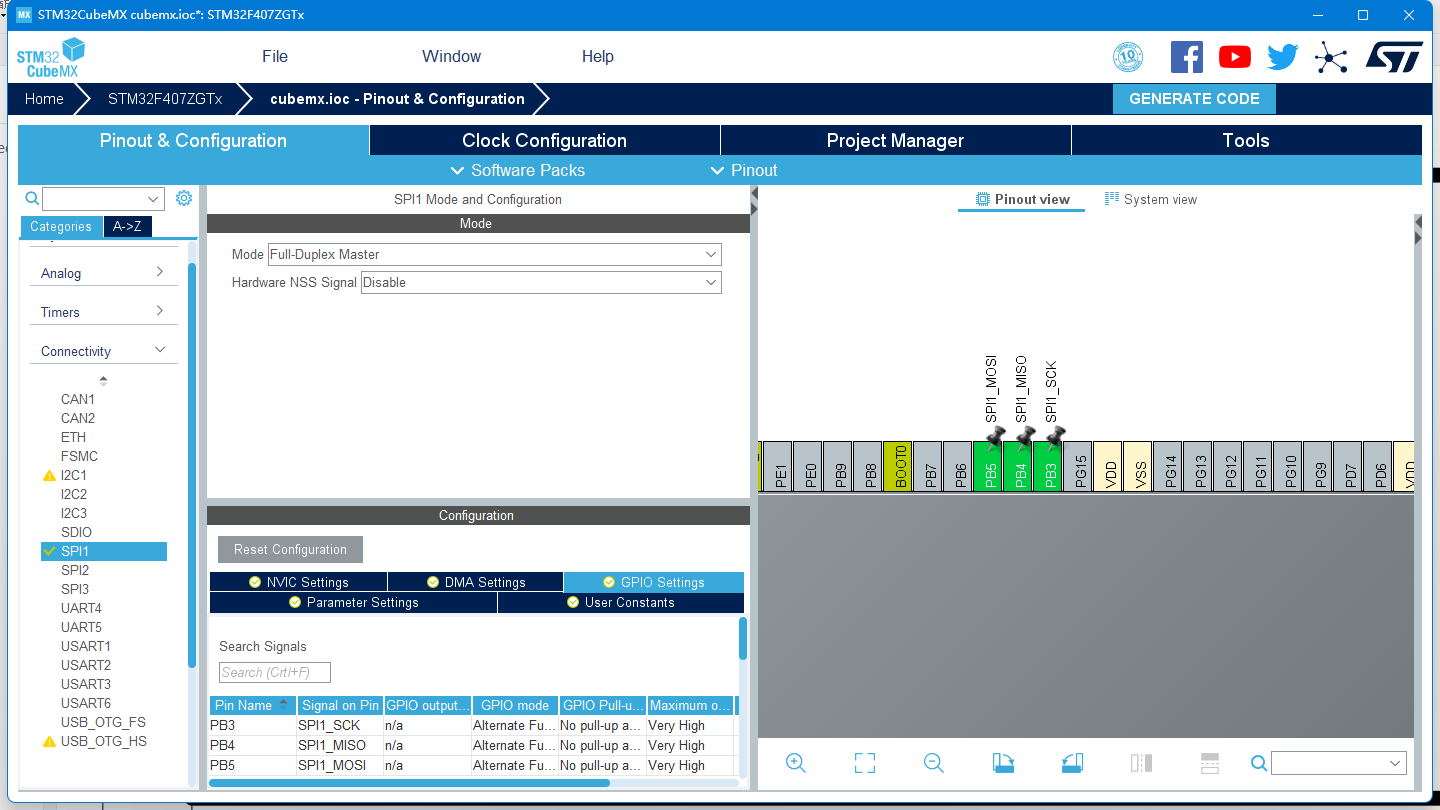 2.4 CubeMX setting內(nèi)配置spi
2.4 CubeMX setting內(nèi)配置spi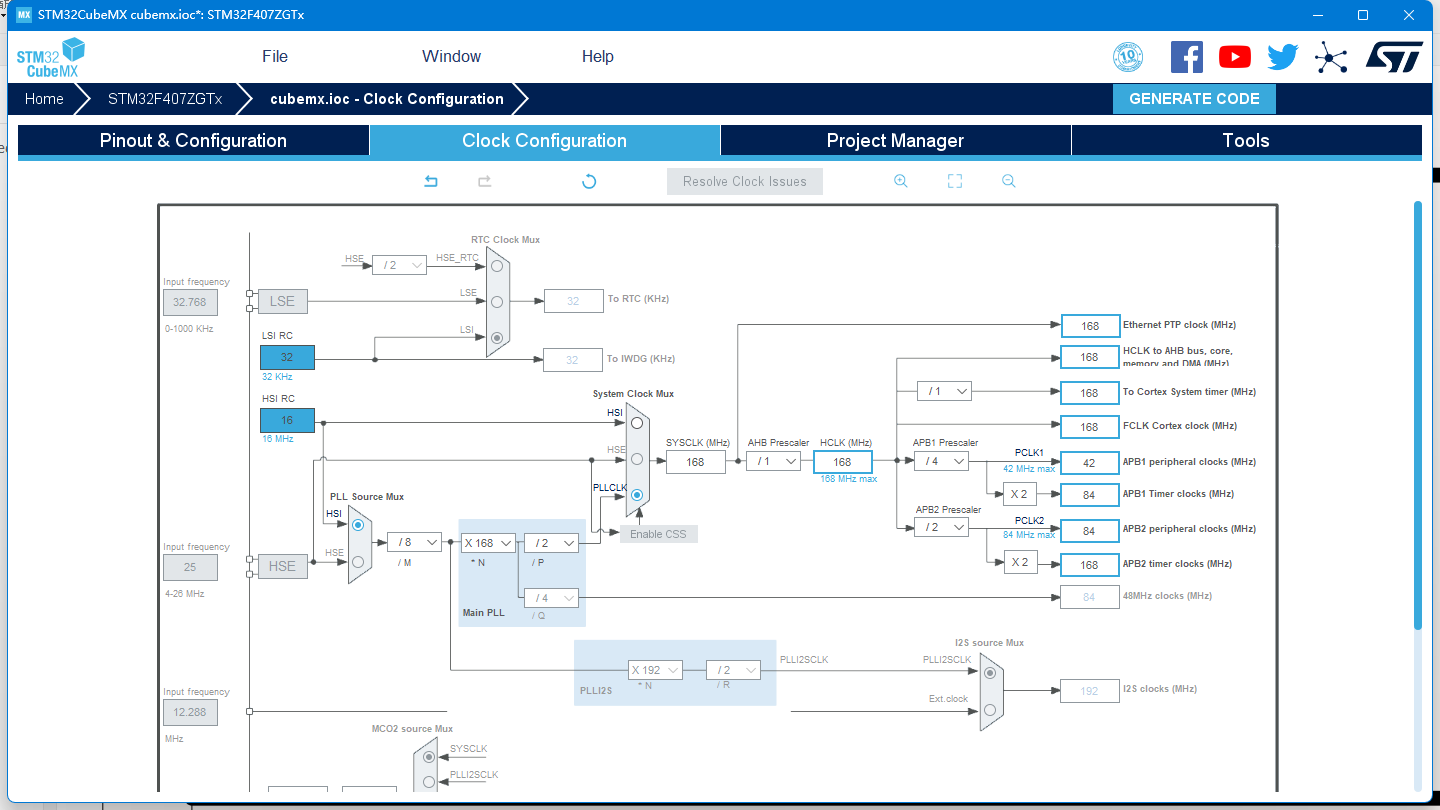 2.5 CubeMX setting內(nèi)配置芯片時鐘
2.5 CubeMX setting內(nèi)配置芯片時鐘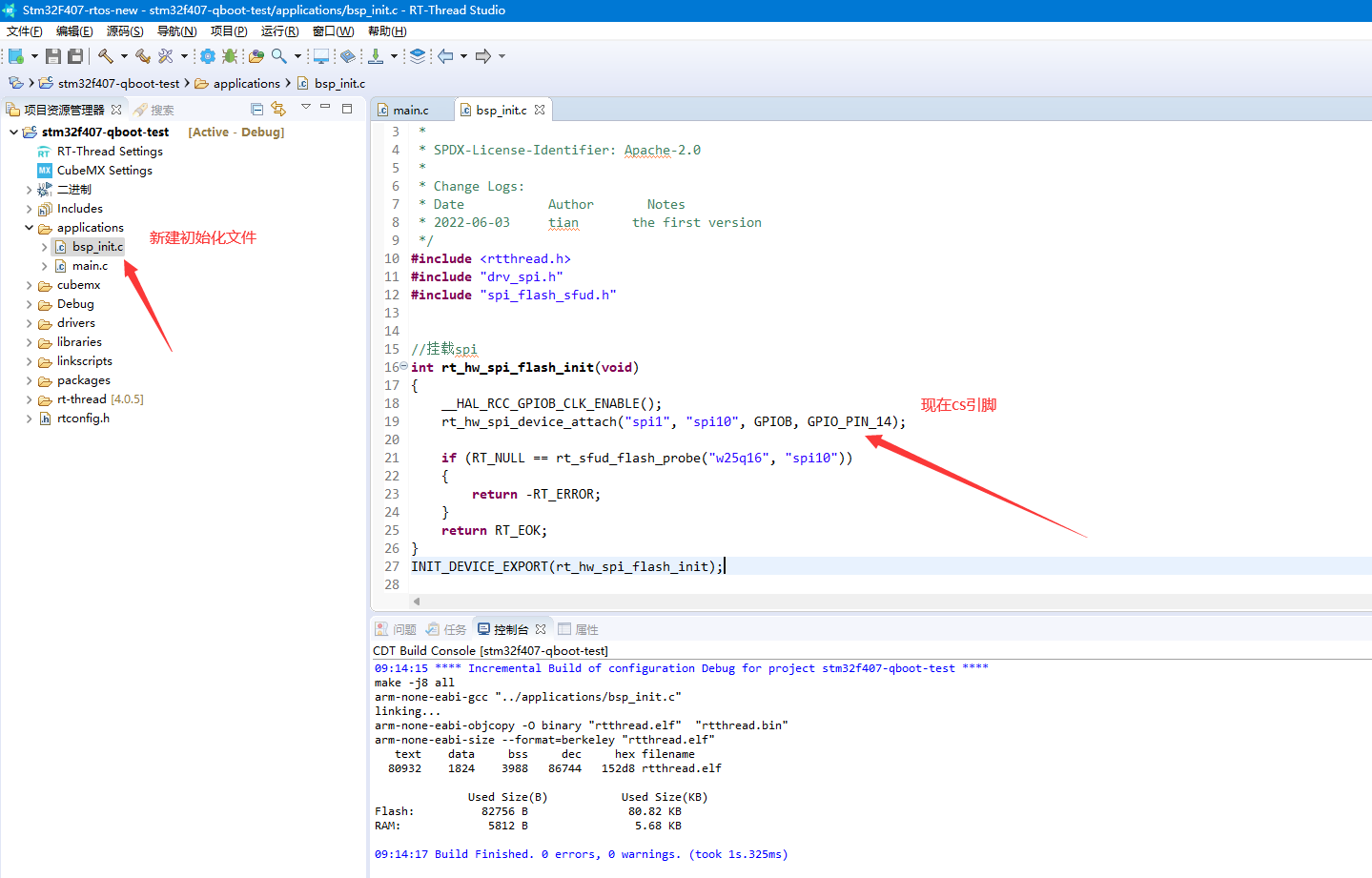 2.6 添加掛載spi的代碼
2.6 添加掛載spi的代碼
//****************************************
//注意這里括號顯示就沒了 自己包含一下頭文件
//****************************************
//這里添加 rtthread.h
//加上 大于小于括號
#include
#include "drv_spi.h"
#include "spi_flash_sfud.h"
//掛載spi
int rt_hw_spi_flash_init(void)
{
__HAL_RCC_GPIOB_CLK_ENABLE(); //片選引腳為PB14
rt_hw_spi_device_attach("spi1", "spi10", GPIOB, GPIO_PIN_14); //片選引腳為PB14
if (RT_NULL == rt_sfud_flash_probe("w25q16", "spi10"))
{
return -RT_ERROR;
}
return RT_EOK;
}
INIT_DEVICE_EXPORT(rt_hw_spi_flash_init);
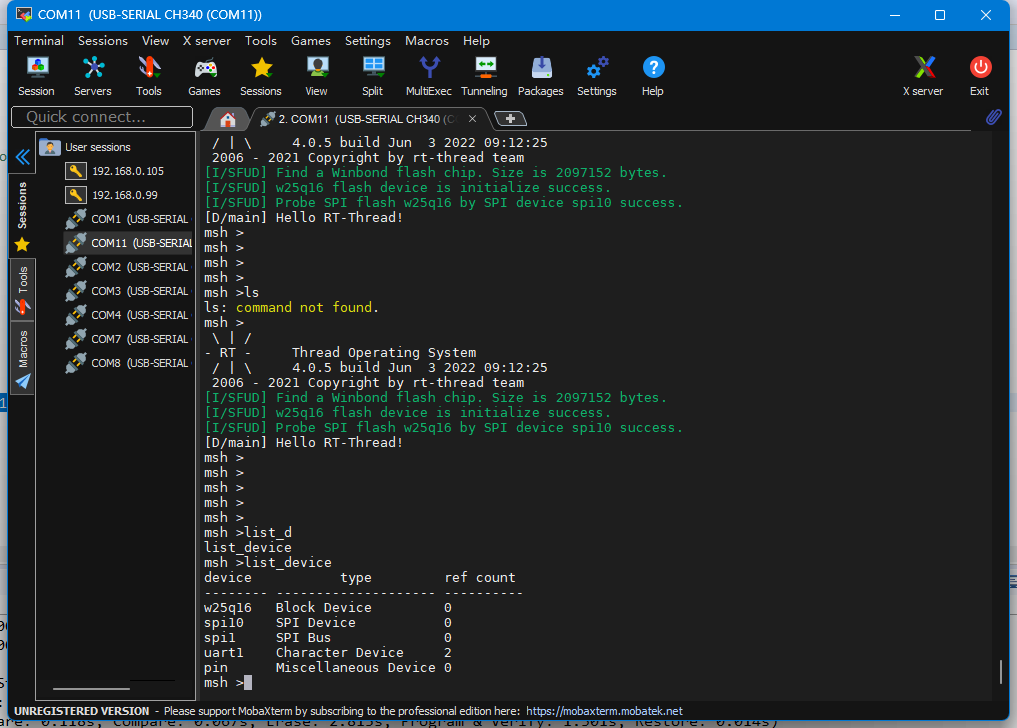 2.7 成功創(chuàng)建spi和w25q16
2.7 成功創(chuàng)建spi和w25q163.使用fal設(shè)置分區(qū)
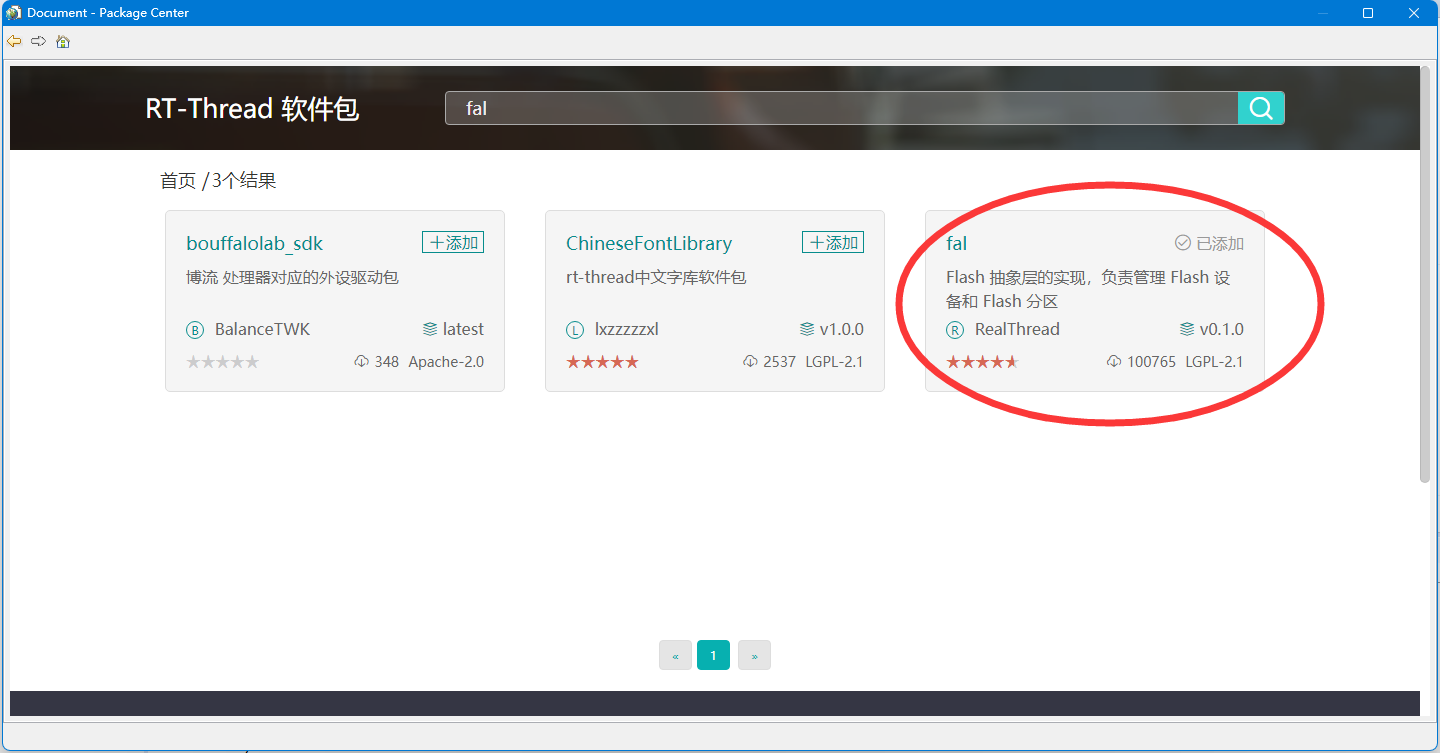 3.1 添加軟件包
3.1 添加軟件包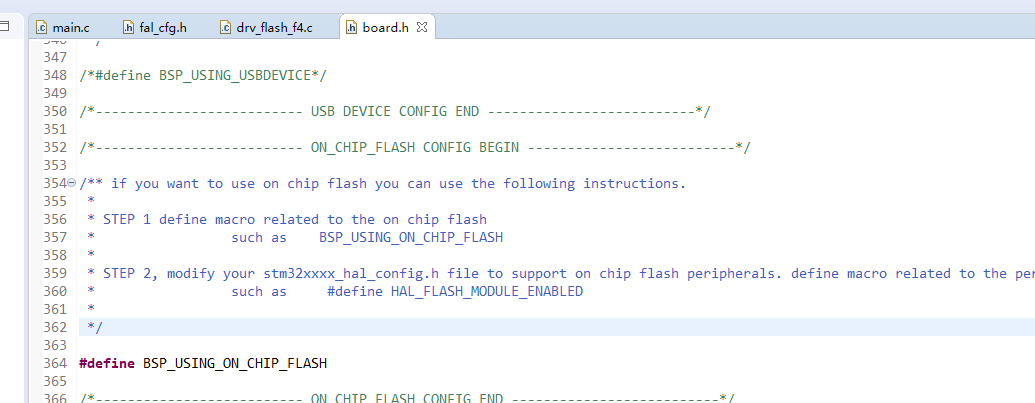 3.2 board.h 里定義
3.2 board.h 里定義 define BSP_USING_ON_CHIP_FLASH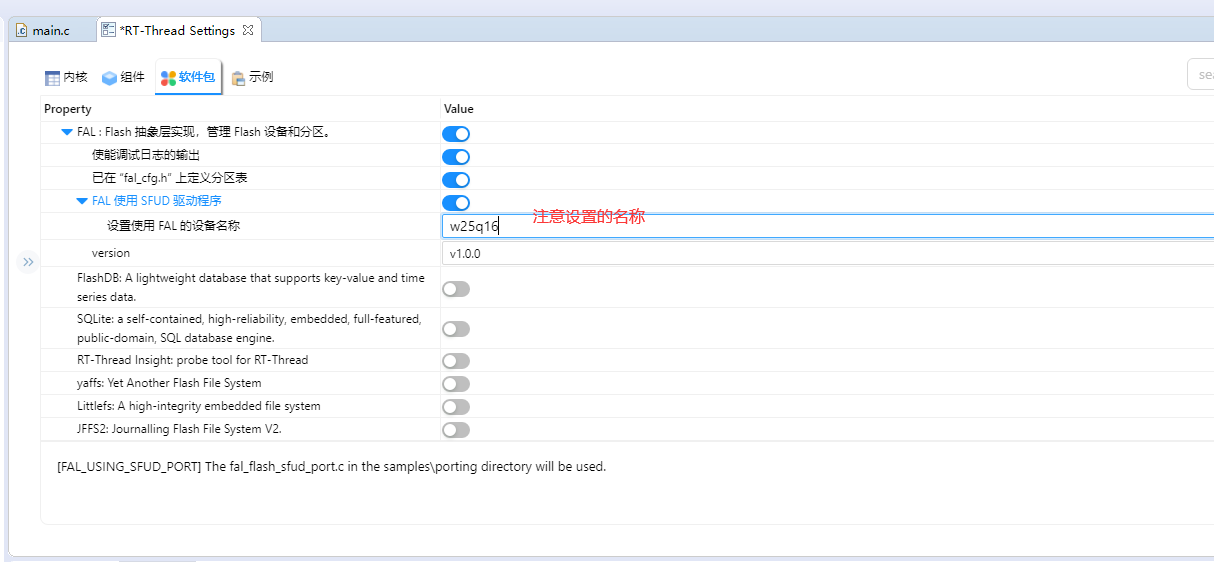 3.3 配置Fal
3.3 配置Fal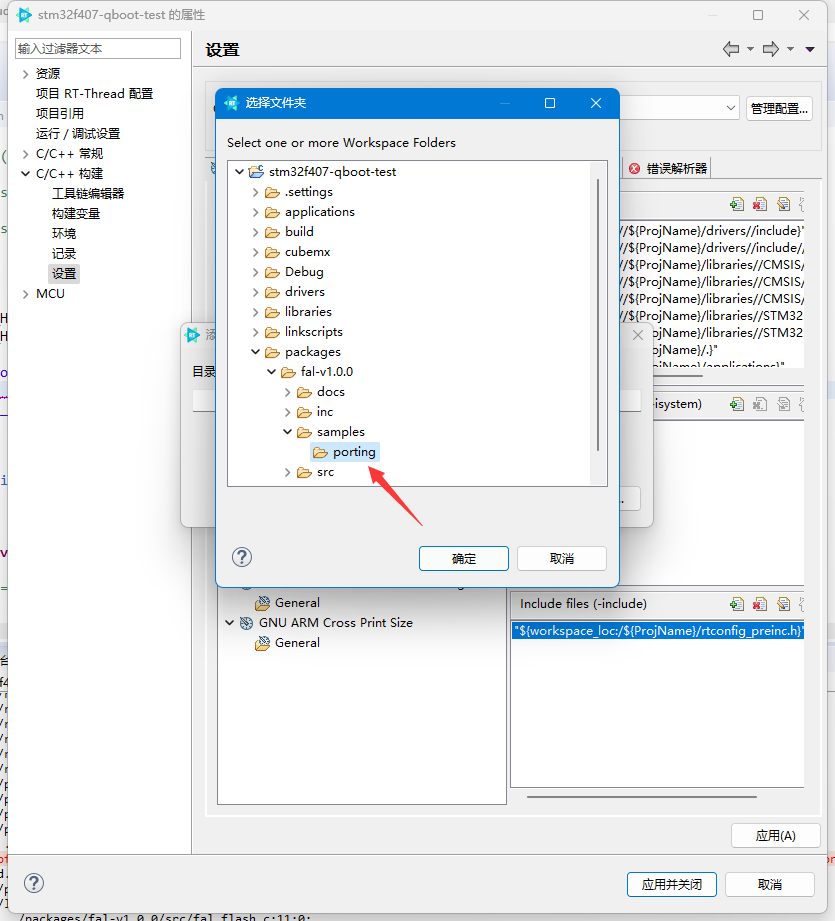 3.4 添加路徑 因為運(yùn)行提示找不到fal_cfg.h的路徑
3.4 添加路徑 因為運(yùn)行提示找不到fal_cfg.h的路徑在此處運(yùn)行后,會發(fā)現(xiàn)如下錯誤:(在這個地方有較多的解決方法,但是有的方法在到后面在使用后續(xù)的ota升級的時候,會擦除到app區(qū)域,具體我也不懂…….)
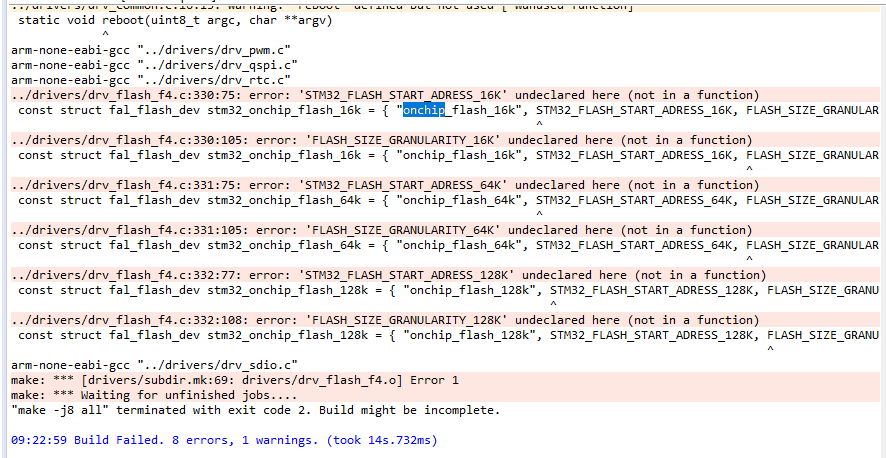 3.5 出現(xiàn)錯誤
3.5 出現(xiàn)錯誤解決方法:(將如下代碼 全部替換 到 drv_flash_f4.c 文件)
/*
* Copyright (c) 2006-2018, RT-Thread Development Team
*
* SPDX-License-Identifier: Apache-2.0
*
* Change Logs:
* Date Author Notes
*/
#include "board.h"
#ifdef BSP_USING_ON_CHIP_FLASH
#include "drv_config.h"
#include "drv_flash.h"
#if defined(PKG_USING_FAL)
#include "fal.h"
#endif
//#define DRV_DEBUG
#define LOG_TAG "drv.flash"
#include
/* Base address of the Flash sectors Bank 1 */
#define ADDR_FLASH_SECTOR_0 ((uint32_t)0x08000000) /* Base @ of Sector 0, 16 Kbytes */
#define ADDR_FLASH_SECTOR_1 ((uint32_t)0x08004000) /* Base @ of Sector 1, 16 Kbytes */
#define ADDR_FLASH_SECTOR_2 ((uint32_t)0x08008000) /* Base @ of Sector 2, 16 Kbytes */
#define ADDR_FLASH_SECTOR_3 ((uint32_t)0x0800C000) /* Base @ of Sector 3, 16 Kbytes */
#define ADDR_FLASH_SECTOR_4 ((uint32_t)0x08010000) /* Base @ of Sector 4, 64 Kbytes */
#define ADDR_FLASH_SECTOR_5 ((uint32_t)0x08020000) /* Base @ of Sector 5, 128 Kbytes */
#define ADDR_FLASH_SECTOR_6 ((uint32_t)0x08040000) /* Base @ of Sector 6, 128 Kbytes */
#define ADDR_FLASH_SECTOR_7 ((uint32_t)0x08060000) /* Base @ of Sector 7, 128 Kbytes */
#define ADDR_FLASH_SECTOR_8 ((uint32_t)0x08080000) /* Base @ of Sector 8, 128 Kbytes */
#define ADDR_FLASH_SECTOR_9 ((uint32_t)0x080A0000) /* Base @ of Sector 9, 128 Kbytes */
#define ADDR_FLASH_SECTOR_10 ((uint32_t)0x080C0000) /* Base @ of Sector 10, 128 Kbytes */
#define ADDR_FLASH_SECTOR_11 ((uint32_t)0x080E0000) /* Base @ of Sector 11, 128 Kbytes */
/* Base address of the Flash sectors Bank 2 */
#define ADDR_FLASH_SECTOR_12 ((uint32_t)0x08100000) /* Base @ of Sector 0, 16 Kbytes */
#define ADDR_FLASH_SECTOR_13 ((uint32_t)0x08104000) /* Base @ of Sector 1, 16 Kbytes */
#define ADDR_FLASH_SECTOR_14 ((uint32_t)0x08108000) /* Base @ of Sector 2, 16 Kbytes */
#define ADDR_FLASH_SECTOR_15 ((uint32_t)0x0810C000) /* Base @ of Sector 3, 16 Kbytes */
#define ADDR_FLASH_SECTOR_16 ((uint32_t)0x08110000) /* Base @ of Sector 4, 64 Kbytes */
#define ADDR_FLASH_SECTOR_17 ((uint32_t)0x08120000) /* Base @ of Sector 5, 128 Kbytes */
#define ADDR_FLASH_SECTOR_18 ((uint32_t)0x08140000) /* Base @ of Sector 6, 128 Kbytes */
#define ADDR_FLASH_SECTOR_19 ((uint32_t)0x08160000) /* Base @ of Sector 7, 128 Kbytes */
#define ADDR_FLASH_SECTOR_20 ((uint32_t)0x08180000) /* Base @ of Sector 8, 128 Kbytes */
#define ADDR_FLASH_SECTOR_21 ((uint32_t)0x081A0000) /* Base @ of Sector 9, 128 Kbytes */
#define ADDR_FLASH_SECTOR_22 ((uint32_t)0x081C0000) /* Base @ of Sector 10, 128 Kbytes */
#define ADDR_FLASH_SECTOR_23 ((uint32_t)0x081E0000) /* Base @ of Sector 11, 128 Kbytes */
/**
* @brief Gets the sector of a given address
* @param None
* @retval The sector of a given address
*/
static rt_uint32_t GetSector(rt_uint32_t Address)
{
rt_uint32_t sector = 0;
if((Address < ADDR_FLASH_SECTOR_1) && (Address >= ADDR_FLASH_SECTOR_0))
{
sector = FLASH_SECTOR_0;
}
else if((Address < ADDR_FLASH_SECTOR_2) && (Address >= ADDR_FLASH_SECTOR_1))
{
sector = FLASH_SECTOR_1;
}
else if((Address < ADDR_FLASH_SECTOR_3) && (Address >= ADDR_FLASH_SECTOR_2))
{
sector = FLASH_SECTOR_2;
}
else if((Address < ADDR_FLASH_SECTOR_4) && (Address >= ADDR_FLASH_SECTOR_3))
{
sector = FLASH_SECTOR_3;
}
else if((Address < ADDR_FLASH_SECTOR_5) && (Address >= ADDR_FLASH_SECTOR_4))
{
sector = FLASH_SECTOR_4;
}
else if((Address < ADDR_FLASH_SECTOR_6) && (Address >= ADDR_FLASH_SECTOR_5))
{
sector = FLASH_SECTOR_5;
}
else if((Address < ADDR_FLASH_SECTOR_7) && (Address >= ADDR_FLASH_SECTOR_6))
{
sector = FLASH_SECTOR_6;
}
else if((Address < ADDR_FLASH_SECTOR_8) && (Address >= ADDR_FLASH_SECTOR_7))
{
sector = FLASH_SECTOR_7;
}
#if defined(FLASH_SECTOR_8)
else if((Address < ADDR_FLASH_SECTOR_9) && (Address >= ADDR_FLASH_SECTOR_8))
{
sector = FLASH_SECTOR_8;
}
#endif
#if defined(FLASH_SECTOR_9)
else if((Address < ADDR_FLASH_SECTOR_10) && (Address >= ADDR_FLASH_SECTOR_9))
{
sector = FLASH_SECTOR_9;
}
#endif
#if defined(FLASH_SECTOR_10)
else if((Address < ADDR_FLASH_SECTOR_11) && (Address >= ADDR_FLASH_SECTOR_10))
{
sector = FLASH_SECTOR_10;
}
#endif
#if defined(FLASH_SECTOR_11)
else if((Address < ADDR_FLASH_SECTOR_12) && (Address >= ADDR_FLASH_SECTOR_11))
{
sector = FLASH_SECTOR_11;
}
#endif
#if defined(STM32F427xx) || defined(STM32F437xx) || defined(STM32F429xx)|| defined(STM32F439xx) || defined(STM32F469xx) || defined(STM32F479xx)
else if((Address < ADDR_FLASH_SECTOR_13) && (Address >= ADDR_FLASH_SECTOR_12))
{
sector = FLASH_SECTOR_12;
}
else if((Address < ADDR_FLASH_SECTOR_14) && (Address >= ADDR_FLASH_SECTOR_13))
{
sector = FLASH_SECTOR_13;
}
else if((Address < ADDR_FLASH_SECTOR_15) && (Address >= ADDR_FLASH_SECTOR_14))
{
sector = FLASH_SECTOR_14;
}
else if((Address < ADDR_FLASH_SECTOR_16) && (Address >= ADDR_FLASH_SECTOR_15))
{
sector = FLASH_SECTOR_15;
}
else if((Address < ADDR_FLASH_SECTOR_17) && (Address >= ADDR_FLASH_SECTOR_16))
{
sector = FLASH_SECTOR_16;
}
else if((Address < ADDR_FLASH_SECTOR_18) && (Address >= ADDR_FLASH_SECTOR_17))
{
sector = FLASH_SECTOR_17;
}
else if((Address < ADDR_FLASH_SECTOR_19) && (Address >= ADDR_FLASH_SECTOR_18))
{
sector = FLASH_SECTOR_18;
}
else if((Address < ADDR_FLASH_SECTOR_20) && (Address >= ADDR_FLASH_SECTOR_19))
{
sector = FLASH_SECTOR_19;
}
else if((Address < ADDR_FLASH_SECTOR_21) && (Address >= ADDR_FLASH_SECTOR_20))
{
sector = FLASH_SECTOR_20;
}
else if((Address < ADDR_FLASH_SECTOR_22) && (Address >= ADDR_FLASH_SECTOR_21))
{
sector = FLASH_SECTOR_21;
}
else if((Address < ADDR_FLASH_SECTOR_23) && (Address >= ADDR_FLASH_SECTOR_22))
{
sector = FLASH_SECTOR_22;
}
else /* (Address < FLASH_END_ADDR) && (Address >= ADDR_FLASH_SECTOR_23) */
{
sector = FLASH_SECTOR_23;
}
#endif
return sector;
}
/**
* Read data from flash.
* @note This operation's units is word.
*
* @param addr flash address
* @param buf buffer to store read data
* @param size read bytes size
*
* @return result
*/
int stm32_flash_read(rt_uint32_t addr, rt_uint8_t *buf, size_t size)
{
size_t i;
if ((addr + size) > STM32_FLASH_END_ADDRESS)
{
LOG_E("read outrange flash size! addr is (0x%p)", (void*)(addr + size));
return -1;
}
for (i = 0; i < size; i++, buf++, addr++)
{
*buf = *(rt_uint8_t *) addr;
}
return size;
}
/**
* Write data to flash.
* @note This operation's units is word.
* @note This operation must after erase. @see flash_erase.
*
* @param addr flash address
* @param buf the write data buffer
* @param size write bytes size
*
* @return result
*/
int stm32_flash_write(rt_uint32_t addr, const rt_uint8_t *buf, size_t size)
{
rt_err_t result = RT_EOK;
rt_uint32_t end_addr = addr + size;
if ((end_addr) > STM32_FLASH_END_ADDRESS)
{
LOG_E("write outrange flash size! addr is (0x%p)", (void*)(addr + size));
return -RT_EINVAL;
}
if (size < 1)
{
return -RT_EINVAL;
}
HAL_FLASH_Unlock();
__HAL_FLASH_CLEAR_FLAG(FLASH_FLAG_EOP | FLASH_FLAG_OPERR | FLASH_FLAG_WRPERR | FLASH_FLAG_PGAERR | FLASH_FLAG_PGPERR | FLASH_FLAG_PGSERR);
for (size_t i = 0; i < size; i++, addr++, buf++)
{
/* write data to flash */
if (HAL_FLASH_Program(FLASH_TYPEPROGRAM_BYTE, addr, (rt_uint64_t)(*buf)) == HAL_OK)
{
if (*(rt_uint8_t *)addr != *buf)
{
result = -RT_ERROR;
break;
}
}
else
{
result = -RT_ERROR;
break;
}
}
HAL_FLASH_Lock();
if (result != RT_EOK)
{
return result;
}
return size;
}
/**
* Erase data on flash.
* @note This operation is irreversible.
* @note This operation's units is different which on many chips.
*
* @param addr flash address
* @param size erase bytes size
*
* @return result
*/
int stm32_flash_erase(rt_uint32_t addr, size_t size)
{
rt_err_t result = RT_EOK;
rt_uint32_t FirstSector = 0, NbOfSectors = 0;
rt_uint32_t SECTORError = 0;
if ((addr + size) > STM32_FLASH_END_ADDRESS)
{
LOG_E("ERROR: erase outrange flash size! addr is (0x%p)\n", (void*)(addr + size));
return -RT_EINVAL;
}
/*Variable used for Erase procedure*/
FLASH_EraseInitTypeDef EraseInitStruct;
/* Unlock the Flash to enable the flash control register access */
HAL_FLASH_Unlock();
__HAL_FLASH_CLEAR_FLAG(FLASH_FLAG_EOP | FLASH_FLAG_OPERR | FLASH_FLAG_WRPERR | FLASH_FLAG_PGAERR | FLASH_FLAG_PGPERR | FLASH_FLAG_PGSERR);
/* Get the 1st sector to erase */
FirstSector = GetSector(addr);
/* Get the number of sector to erase from 1st sector*/
NbOfSectors = GetSector(addr + size - 1) - FirstSector + 1;
/* Fill EraseInit structure*/
EraseInitStruct.TypeErase = FLASH_TYPEERASE_SECTORS;
EraseInitStruct.VoltageRange = FLASH_VOLTAGE_RANGE_3;
EraseInitStruct.Sector = FirstSector;
EraseInitStruct.NbSectors = NbOfSectors;
if (HAL_FLASHEx_Erase(&EraseInitStruct, (uint32_t *)&SECTORError) != HAL_OK)
{
result = -RT_ERROR;
goto __exit;
}
__exit:
HAL_FLASH_Lock();
if (result != RT_EOK)
{
return result;
}
LOG_D("erase done: addr (0x%p), size %d", (void*)addr, size);
return size;
}
#if defined(PKG_USING_FAL)
static int fal_flash_read(long offset, rt_uint8_t *buf, size_t size);
static int fal_flash_write(long offset, const rt_uint8_t *buf, size_t size);
static int fal_flash_erase(long offset, size_t size);
const struct fal_flash_dev stm32_onchip_flash = { "onchip_flash", STM32_FLASH_START_ADRESS, STM32_FLASH_SIZE, 0x800U, {NULL, fal_flash_read, fal_flash_write, fal_flash_erase} };
static int fal_flash_read(long offset, rt_uint8_t *buf, size_t size)
{
return stm32_flash_read(stm32_onchip_flash.addr + offset, buf, size);
}
static int fal_flash_write(long offset, const rt_uint8_t *buf, size_t size)
{
return stm32_flash_write(stm32_onchip_flash.addr + offset, buf, size);
}
static int fal_flash_erase(long offset, size_t size)
{
return stm32_flash_erase(stm32_onchip_flash.addr + offset, size);
}
#endif
#endif /* BSP_USING_ON_CHIP_FLASH */
再修改 fal_cfg.h 文件設(shè)置自己的分區(qū)設(shè)置(分區(qū)根據(jù)實際情況設(shè)置)
/*
* Copyright (c) 2006-2018, RT-Thread Development Team
*
* SPDX-License-Identifier: Apache-2.0
*
* Change Logs:
* Date Author Notes
*/
#ifndef _FAL_CFG_H_
#define _FAL_CFG_H_
//****************************************
//注意這里括號顯示就沒了 自己包含一下頭文件
//****************************************
//加上 大于小于括號
#include rtconfig.h
#include board.h
#define NOR_FLASH_DEV_NAME "w25q16"
/* ===================== Flash device Configuration ========================= */
extern const struct fal_flash_dev stm32_onchip_flash;
/* ===================== Flash device Configuration ========================= */
extern struct fal_flash_dev nor_flash0;
/* flash device table */
#define FAL_FLASH_DEV_TABLE \
{ \
&stm32_onchip_flash, \
&nor_flash0, \
}
/* ====================== Partition Configuration ========================== */
#ifdef FAL_PART_HAS_TABLE_CFG
/* partition table */
#define FAL_PART_TABLE \
{ \
/* name dev 開始地址 大小 0 */ \
{FAL_PART_MAGIC_WORD, "qboot", "onchip_flash", 0, 128*1024, 0}, \
{FAL_PART_MAGIC_WORD, "app", "onchip_flash", 128*1024, 445*1024, 0}, \
{FAL_PART_MAGIC_WORD, "factory", "onchip_flash", (128+448)*1024, 445*1024, 0}, \
{FAL_PART_MAGIC_WORD, "filesystem", NOR_FLASH_DEV_NAME, 0, 1020*1024, 0}, \
{FAL_PART_MAGIC_WORD, "download", NOR_FLASH_DEV_NAME, 1024*1024, 510*1024, 0}, \
{FAL_PART_MAGIC_WORD, "easyflash", NOR_FLASH_DEV_NAME, (1024+512)*1024, 510*1024, 0}, \
}
#endif /* FAL_PART_HAS_TABLE_CFG */
#endif /* _FAL_CFG_H_ */
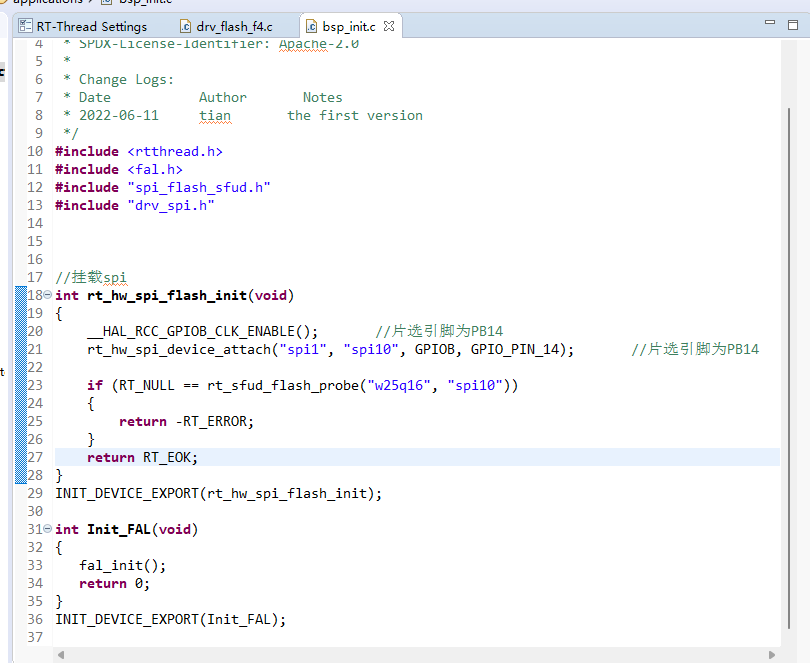 3.6 初始化工作
3.6 初始化工作
//****************************************
//注意這里括號顯示就沒了 自己包含一下頭文件
//****************************************
//這里添加 fal.h rtthread.h
//加上 大于小于括號
#include
#include
#include "drv_spi.h"
#include "spi_flash_sfud.h"
//注意fal的初始化要在外部flash初始化之后
int Init_FAL(void)
{
fal_init();
return 0;
}
INIT_DEVICE_EXPORT(Init_FAL);
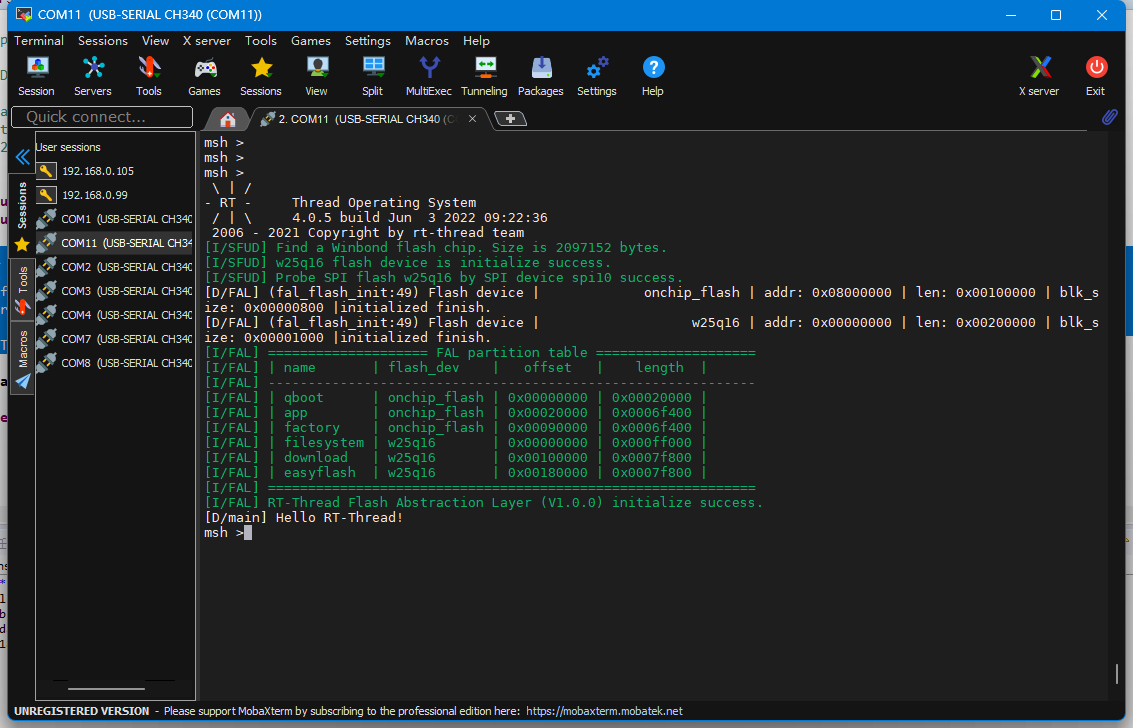 3.7 可以看見分區(qū)已經(jīng)成功了
3.7 可以看見分區(qū)已經(jīng)成功了4.開始添加qboot
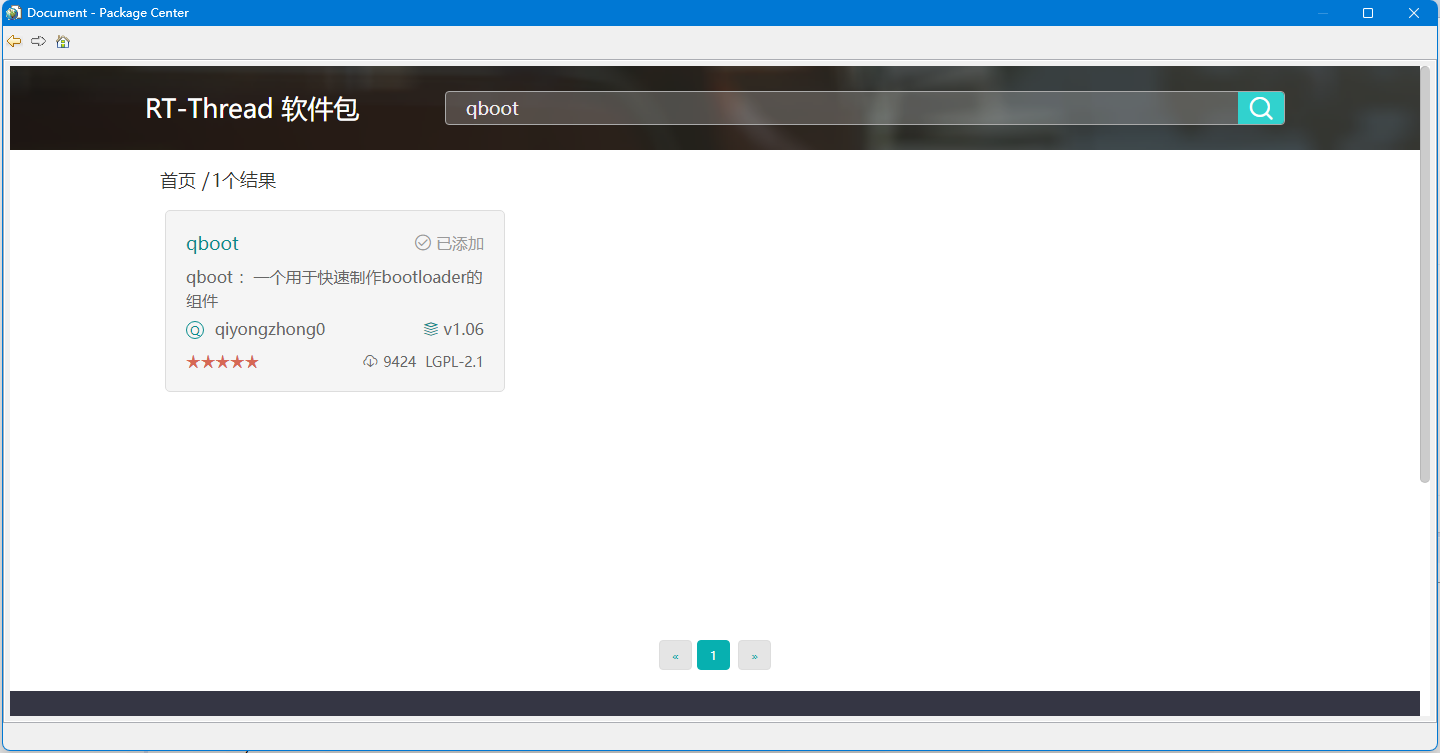 4.1 添加qboot
4.1 添加qboot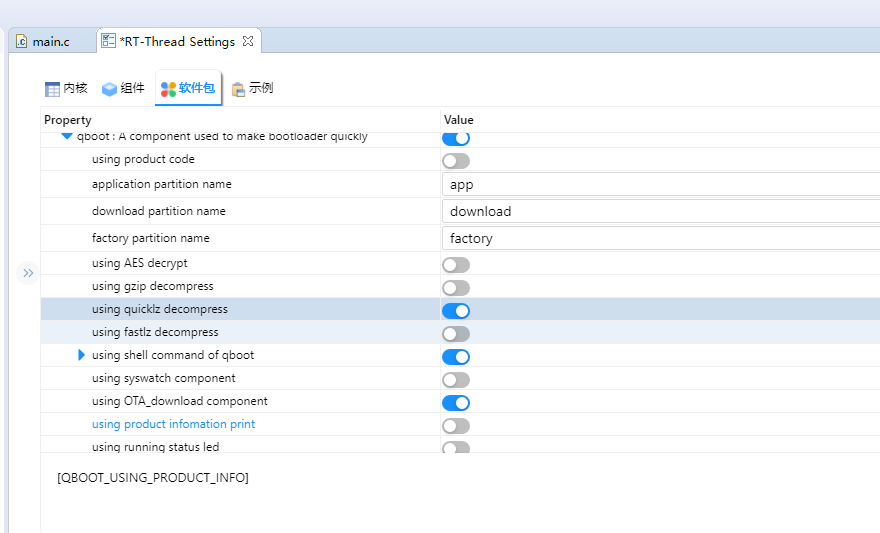 4.2 配置qboot 把沒用上的都關(guān)了
4.2 配置qboot 把沒用上的都關(guān)了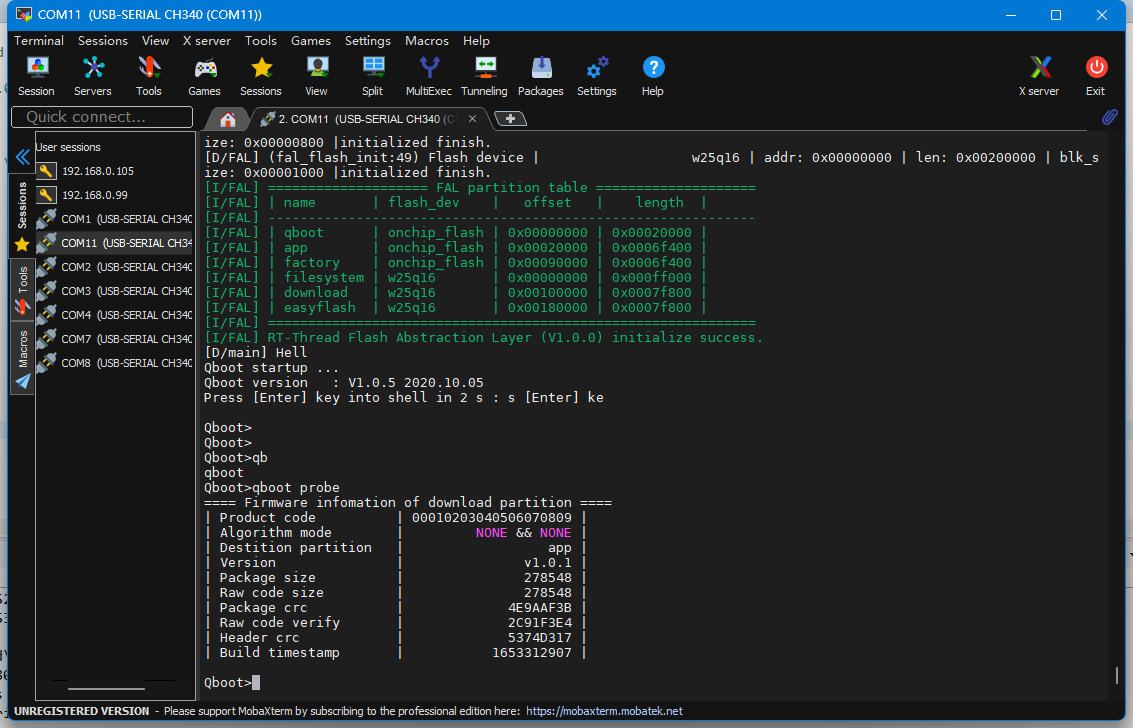 4.3 qboot運(yùn)行成功(上面打印問題把main函數(shù)里面打印去掉就好了)
4.3 qboot運(yùn)行成功(上面打印問題把main函數(shù)里面打印去掉就好了)移植app工程過程
1.創(chuàng)建工程在main中添加如下
#include "stm32f4xx_hal.h"
/*app partition begin address*/
//app分區(qū)的地址
#define RT_APP_PART_ADDR 0x08020000
static int ota_app_vtor_reconfig(void)
{
#define NVIC_VTOR_MASK 0x3FFFFF80
/* Set the Vector Table base location by user application firmware definition */
SCB->VTOR = RT_APP_PART_ADDR & NVIC_VTOR_MASK;
return 0;
}
INIT_BOARD_EXPORT(ota_app_vtor_reconfig);
int F4_clock_information(void)
{
LOG_I("System Clock information");
LOG_I("SYSCLK_Frequency = %d", HAL_RCC_GetSysClockFreq());
LOG_I("HCLK_Frequency = %d", HAL_RCC_GetHCLKFreq());
LOG_I("PCLK1_Frequency = %d", HAL_RCC_GetPCLK1Freq());
LOG_I("PCLK2_Frequency = %d", HAL_RCC_GetPCLK2Freq());
return RT_EOK;
}
INIT_DEVICE_EXPORT(F4_clock_information);
2.修改 \linkscripts\STM32F407ZG\link.lds 內(nèi)的起始地址

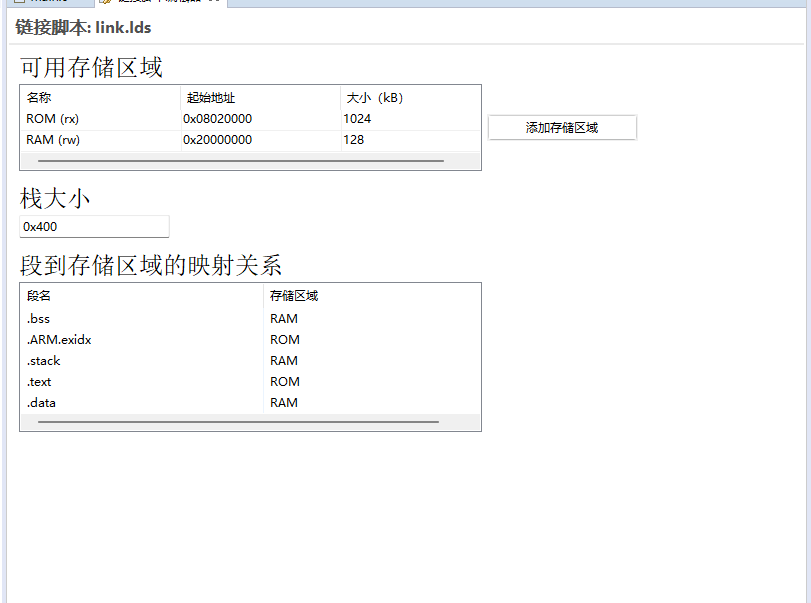 2.1 將0x08000000改為你的app分區(qū)的地址
2.1 將0x08000000改為你的app分區(qū)的地址3.成功運(yùn)行結(jié)果
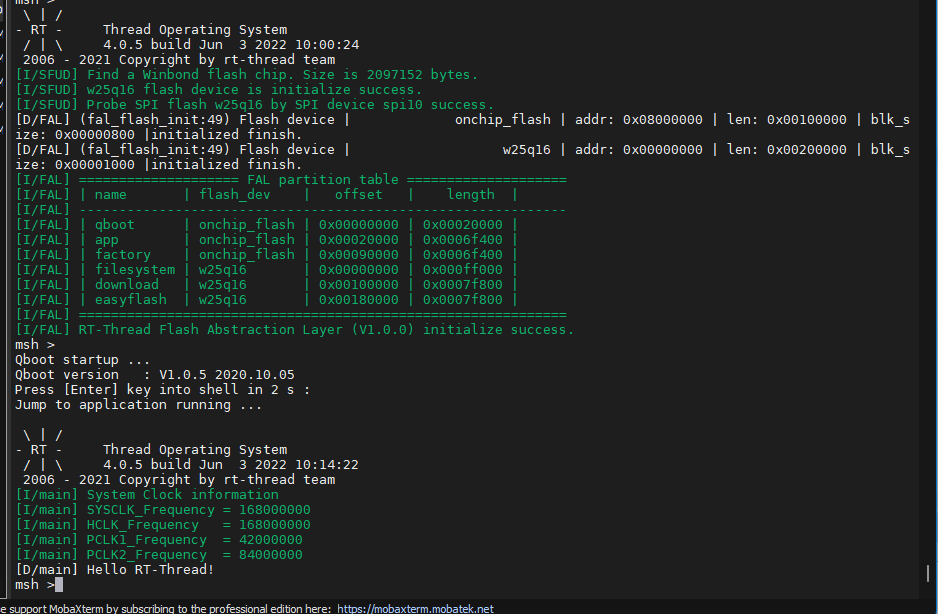 3.1 最基本的app已經(jīng)成功運(yùn)行
3.1 最基本的app已經(jīng)成功運(yùn)行附帶一個工程文件
https://github.com/Letian-stu/Stm32F407-rtos-qboot-app-prj
Stm32F4-spi-qboot-mini
- 對qboot的移植;
- 分區(qū)設(shè)置;
- 可以使用ymodem_ota;
Stm32F4-spi-usb-at
- 使用esp8266實現(xiàn)連接網(wǎng)絡(luò);
- http_ota;
- 使能usb-device對w25q16的filesystem讀寫;
聲明:本文內(nèi)容及配圖由入駐作者撰寫或者入駐合作網(wǎng)站授權(quán)轉(zhuǎn)載。文章觀點僅代表作者本人,不代表電子發(fā)燒友網(wǎng)立場。文章及其配圖僅供工程師學(xué)習(xí)之用,如有內(nèi)容侵權(quán)或者其他違規(guī)問題,請聯(lián)系本站處理。
舉報投訴
-
STM32
+關(guān)注
關(guān)注
2264文章
10854瀏覽量
354305 -
STM32F407
+關(guān)注
關(guān)注
15文章
187瀏覽量
29332 -
RTThread
+關(guān)注
關(guān)注
7文章
132瀏覽量
40776
發(fā)布評論請先 登錄
相關(guān)推薦
RTThread之操作系統(tǒng)移植
RTThread完整版學(xué)習(xí)(RCEA考試練習(xí))之操作系統(tǒng)移植(照貓畫虎版)RTThread的一大特色就是有豐富免費(fèi)的組件可以用,但是對于我這個初學(xué)者來說很難習(xí)慣它必須使用它的模板完成任
發(fā)表于 08-03 06:42
將ucosii移植到stm32F107的學(xué)習(xí)筆記
今天開始寫ucosii學(xué)習(xí)筆記,希望能堅持下去,能夠?qū)cosii移植到stm32F107。大家一起努力吧。
發(fā)表于 08-23 08:40
RTthread移植代碼自動生成方案
RTthread再學(xué)習(xí)記錄前言一、RTthread移植代碼自動生成方案二、使用CUBEMX在STM32F4上移植RTT1.官方提供的教程2.
發(fā)表于 02-11 06:29
將基于rtthread的項目移植到其他平臺的經(jīng)驗分享
和大家分享下將基于rtthread的項目移植到其他平臺的經(jīng)驗。背景最近做了一個物聯(lián)網(wǎng)項目移植。原先的項目使用的硬件平臺為stm32f401+sim800c(mcu + 2G modem),軟件平臺為
發(fā)表于 02-17 07:57
rtthread的學(xué)習(xí)筆記分享
1、rtthread定時器rtthread定時器的定時時間以時鐘一個節(jié)拍的時間為單位,創(chuàng)建并激活的定時器會以超時時間的大小排序,鏈接在rt_timer_list上,在每次硬件中斷執(zhí)行
發(fā)表于 03-15 14:07
華大單片機(jī)移植RTThread操作系統(tǒng)教程及代碼
1.華大單片機(jī)型號選擇2.RTThread源碼下載2.1 .資料說明2.3.源碼下載3.移植過程3.1.新建華大單片機(jī)最小系統(tǒng)工程模板,這里不展開3.2.在Keil MDK加入Rtthread
發(fā)表于 06-27 14:41
使用rtthread nano移植LED程序的步驟
最近做一些驗證實驗的時候想使用rtthread nano來做,這樣在內(nèi)存受限的MCU上也能使用。下面開始移植工作:STM32CubeMX生成工程使用ST官方的STM32CubeMX生成MDK工
發(fā)表于 07-11 10:56
【原創(chuàng)精選】RT-Thread征文精選技術(shù)文章合集
專欄作者 :Thomas的小火車簡介:和大家一起學(xué)習(xí)分享進(jìn)步。基于ESP32C3運(yùn)行RT-THREADNO9 專欄作者 :tian的個人專欄使用rtthread移植qboot
發(fā)表于 07-26 14:56
華大單片機(jī)移植RTThread操作系統(tǒng)
3.1.新建華大單片機(jī)最小系統(tǒng)工程模板,這里不展開3.2.在Keil MDK加入Rtthread代碼3.3添加rtthread源碼到工程中3.4 添加完成的樣子3.5
發(fā)表于 11-17 17:21
?53次下載

【STM32F767】使用RTThread和TouchGFX實現(xiàn)DIY數(shù)字儀表(一)——使用STM32CUBMX5.6移植touchGFX4.13
TouchGFX移植到RTThread系統(tǒng)3.使用RT-Thread Studio實現(xiàn)DIY數(shù)字儀表(三)——RTThread系統(tǒng)實現(xiàn)物聯(lián)網(wǎng)平臺4.使用RT-Thread Studio實現(xiàn)DIY...
發(fā)表于 12-05 16:06
?12次下載

rtthread套娃移植
和大家分享下將基于rtthread的項目移植到其他平臺的經(jīng)驗。背景最近做了一個物聯(lián)網(wǎng)項目移植。原先的項目使用的硬件平臺為stm32f401+sim800c(mcu + 2G modem),軟件平臺為
發(fā)表于 12-20 19:45
?13次下載

【rtthread學(xué)習(xí)筆記系列】第二篇:中斷
rtthread會在中斷的前期處理中切換棧指針到預(yù)先留出的中斷棧空間,等中斷退出時恢復(fù)用戶的棧指針。1.3 中斷低半部處理
發(fā)表于 01-25 17:53
?0次下載

RTThread完整版學(xué)習(xí)之操作系統(tǒng)移植
RTThread的一大特色就是有豐富免費(fèi)的組件可以用,但是對于我這個初學(xué)者來說很難習(xí)慣它必須使用它的模板完成任務(wù),而且在stm32也已經(jīng)放棄了對標(biāo)準(zhǔn)庫的支持,這讓我這個一直使用標(biāo)準(zhǔn)庫的菜鳥感到很是頭大。
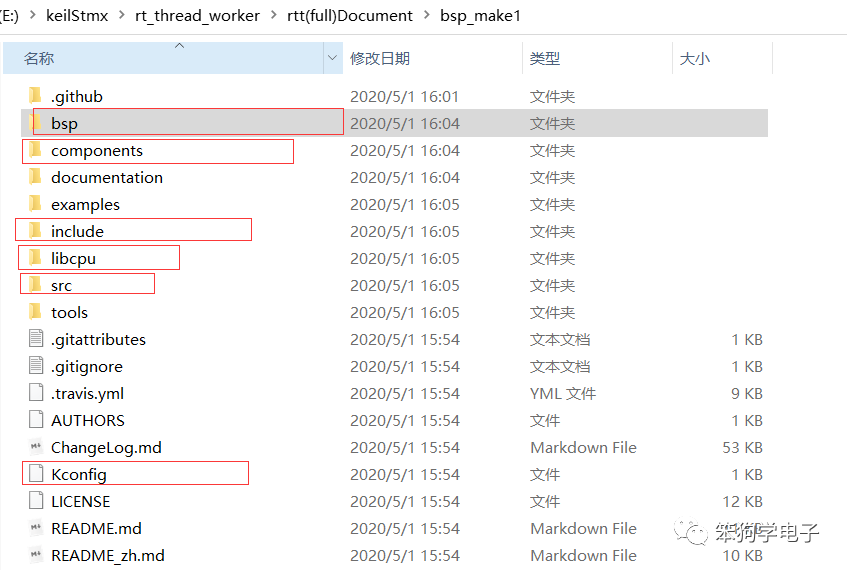




 使用rtthread移植qboot工程的學(xué)習(xí)筆記
使用rtthread移植qboot工程的學(xué)習(xí)筆記










評論